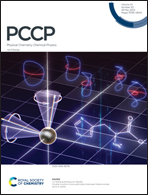Room-temperature half-metals induced via chemical surface modification: 2D Mn2Se2 monolayer†
Abstract
Compared with various antiferromagnetic (AFM) materials, two-dimensional (2D) room-temperature ferromagnetic (FM) materials are rarely discovered because of the geometrically determined spin interactions. Since 2D FM materials have shown great potential in the next-generational information devices, it is quite important to design new FM materials based on the reported AFM materials. Here, in this study, we found that the Mn2Se2 monolayer can be converted to half-metal from AFM semiconductor at room temperature by edge modification of certain chemical groups (such as –Cl, –Br, –I, and –S) based on systematical first-principles calculations. Our results show that the adsorbed chemical groups significantly modify the electronic states of Mn ions and the resulting spin interactions. Moreover, our results indicate that the Curie temperatures (Tc) of some Mn2Se2 monolayer derivatives approach or even exceed room temperature, among which Curie temperatures after chemical modification by –Cl, –Br, –I, –S are 290 K, 320 K, 400 K, and 1050 K, respectively. Thus, chemical modifications can be one of the effective methods to construct 2D FM materials in experiments.


 Please wait while we load your content...
Please wait while we load your content...